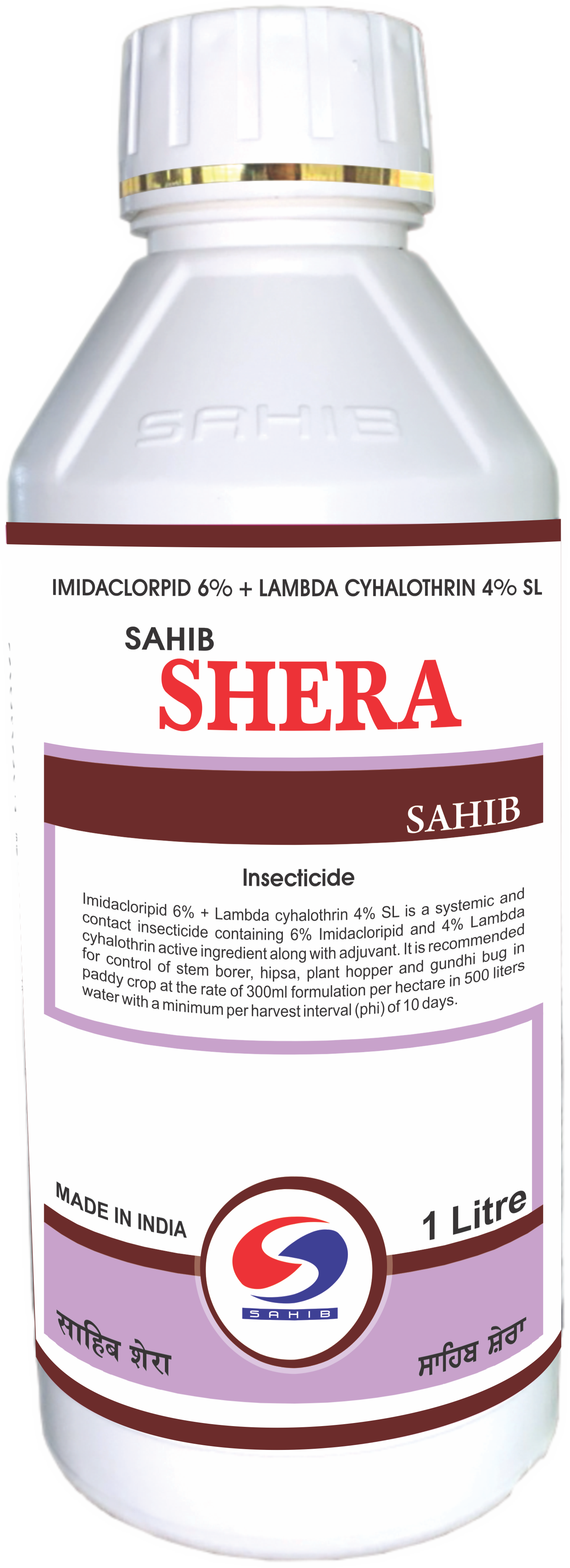
SAHIB SHERA
IMIDACLORPID 6% + LAMBDA CHALOTHRIN 4% SL
Sahib Shera is a systemic and contact insecticide containing 6% Imidacloripid and 4% Lambda cyhalothrin
active ingredient along with adjuvant. It is recommended for control of stem borer, hipsa, plant hopper and gundhi bug in paddy crop at the rate of 300ml formulation per hectare in 500 liters water with a minimum per harvest interval (phi) of 10 days.
- Availability In Stock
- Shipping 01 day shipping. Free pickup today
- Weight 0.5 kg
- Share on
AI (gm)Crop(s) Common Name of Pest Dosage/HA Dilution in Waterin water (liter) Waiting Period between last spray to harvestdays Re-entry after each Applicatio n (In Hours) Formulation (ml) Paddy Stem Borer, Hipsa, Plant hopper and Gundhi Bug 18+12 300 500 10 -
Crop : Paddy, Pre-Harvest Interval : 10 days
Weather condition : Clear without rain & high wind
Crop stage for application : After tillering at the start of panicle initiations stage on the first appearance of insect.
Application Techniques : Foliar Spray Method
Equipment type : Knapsack, high volume knapsack, power/battery operated sprayer, compression knapsack and foot sprayer.
Nozzle type : Hollow cone or cut nozzle. Dosage: Imidacloripid 6% + Lambda Cyhalothrin 4% SL @ 300ml/ha.
Instruction for mixing : Mix insecticide in still or low wind conditions. Stand upwind of the pesticide, Begin by filling the spray tank 1/3 to ½ full with clean water. NEVER put the insecticide in first and then top with water. Start agitating and then add the required quantity of chemical.
Continue agitating while filling the tank, Prevent overflow. Do not leave your tank unattended.
Application Timing : Apply insecticide during the early morning (before sunrise) or evening.
Frequency including maximum number of prays : Maximum two spray at 15-20 days intervals.
Precautions to be taken to avoid harm to be beneficial insects like honey bees and natural enemies of pests shall be furnished : To protect pollinators, avoid spraying when flowers are in bloom. Apply insecticide during the evening or early morning when pollinators (bees) are less active. Identify the insect & target your application to specific areas where the insect is pest to reduce harm to nature enemies and pollinators.
Practices to be followed for usage of insecticide in confined areas, such as glasshouse, poly house etc : Not recommended for use in confined areas.
1. Store the insecticide away from the reach of children. irresponsible persons and animals.
2. Read and follow all instructions given on the label and leaflet very carefully before use and show these to physician in case of accidental poisoning.
3. Use goggles, gloves and protective clothing while handling the insecticide. insecticide should not come in contact with skin and eyes. wear a face mask to avoid inhalation of the poison.
4. Do not eat, drink, smoke or chew tobacco while handling insecticide.
5. Call a physician immediately if any of the symptoms of poisoning appear in person who is handling or recently handled insecticide.
warning:
1. Not to be used on crops and pests other than those mentioned on the label and leaflet.
2. Not to be used for post-harvest treatments.
3. Destroy the container after use as specified on leaflet.
Apathy, myatonia, tremor, difficult breathing, myospasms, nervousness, anxiety, headache, nausea, vomiting, diarrhea, cough, profuse watery salivation, eye irritation, burning and itching of eyes, lacrimation corner damage, periorbital edema, abdominal pain and cramps, gastritis, dizziness, burning sensation in the mouth, burning, itching, tingling or numbness of the face, skin irritation, allergies, airway irritation, rhinitis, sneezing, running nose and irritation, pulmonary edema and hypersensitivity pneumonitis, laryngitis, pharyngitis, wheezing, chest pain broncho spasm, unsteady gait, coarse tremor, sympathetic activation, increased extensor tone, moderate reflex hyperexcitability, ataia, seizures, choreoathetosis, paresthesia, hyperglycemia, convulsion, coma and death.
1. Store in a cool and dry place. Room used for storage must be well built and ventilated and of sufficient dimensions to avoid contamination with vapour.
2. Store the insecticide in its original pack away from the reach of children, irresponsible persons and animals in a separate room under lock and key.
3. Animal feed should not be stored in room where the chemical is stored.
4. Do not use open fire/flame in the place of storage.
1. If ingested: If person is conscious and alert, rinse mouth with water and give 1or 2 glasses of water of drink. Never give anything by mouth to an unconscious person. Call the doctor. Do not induce vomiting until and unless desired by attending physician.
2. If inhaled: Take the patient to fresh air and take care of body temperature. If patient is not breathing with difficulty, give artificial respiration preferably with mouth to mouth breathing. Consult a physician.
3. In case of eye contact: Rinse gently with plenty of water for at least 15 minutes. If pain, irritation, redness or photophobia persists, consult eye specialist.
4. In case of skin contact: Wash thoroughly the affected part of the body with soap and plenty of water including hairs and under fingernails. if pain, redness or irritation persists, consult a doctor. All the contaminated clothes should be segregated and thoroughly washed with soap and water separately before use.
Antidote: No specific antidote. treat symptomatically.